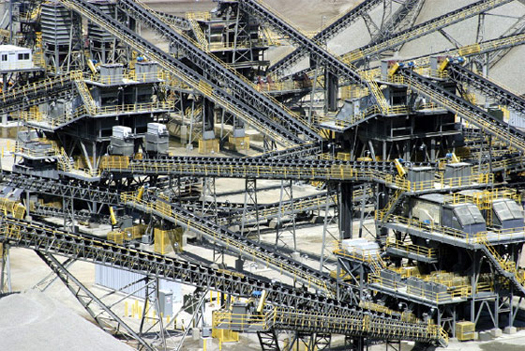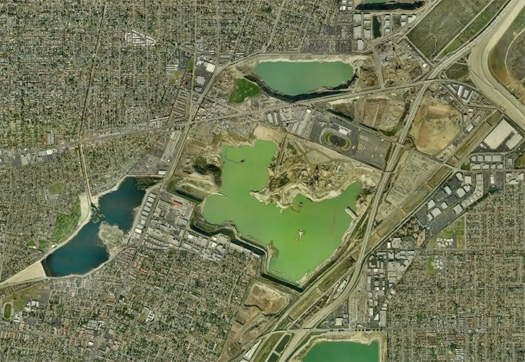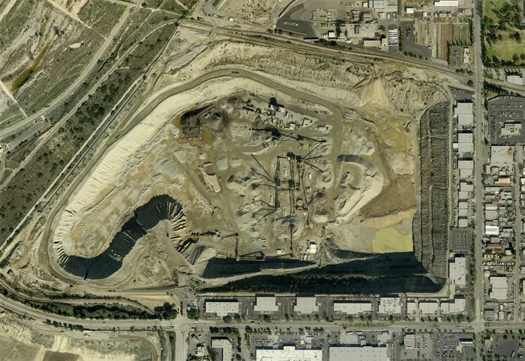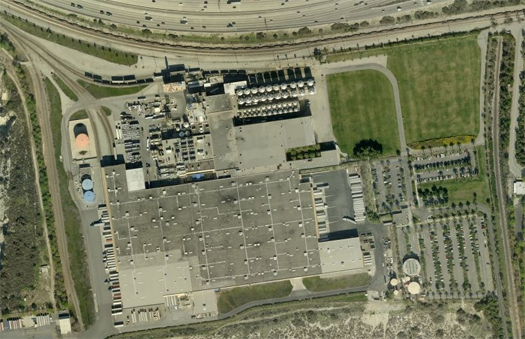We’re back from our week off with another installment of Reading the Infrastructural City; if you haven’t been following along, you can catch up on the series here and see the introductory post here.

[Aggregate operation in the Reliance pit mine, Irwindale, California; photograph by Steve Rowell, via CLUI]
The fourth chapter of The Infrastructural City, “Margins in our Midst: Gravel”, is written by Matthew Coolidge, founder and director of mammoth‘s favorite Los Angeles-based landscape research organization, the Center for Land Use Interpretation. In “Margins”, Coolidge describes the curious situation of Irwindale, a suburb of Los Angeles, playing on the use of the term “margin” to refer both to the edge condition of the city — Irwindale “lies at the base of the San Gabriel Mountains”, which delineate the northern limits of greater Los Angeles — and to the rock aggregate mined in Irwindale.

[Pit mines in southwest Irwindale, via Bing Maps]
The rather wonderful reality, perhaps often obscured by the seeming banality of concrete and asphalt, is that both the buildings of Los Angeles and the spaces between them — streets, courtyards, sidewalks, driveways — are constructed from tiny shards of the surrounding mountain ranges, ossified with cement and petroleum. Though concrete and asphalt often seem like infinitely available materials — only becoming visible once they are whole and ready for use in the beds of asphalt pavers and concrete mixers — they are, in fact, associated with specific landscapes of extraction, much like any other product of contemporary society. For the greater Los Angeles region, Irwindale is the locus of that extraction, a small city pitted by seventeen major aggregate quarries, “so full of holes that more of the land in the city is a pit than not”:
“Of the seventeen major pits in the Irwindale area only four are being mined at the moment. Many of the others are idle, having already been mined to their permitted depth of 200 feet, and having met their limitations in size by running up to the edges of adjacent properties and roadways. In many cases the material extends to a thousand feet deep and the quarries are trying to get permits to go deeper. [One of the main pit operators,] Vulcan, estimates that if they could go another 150 feet, their Irwindale pits would have another thirty years of life. The city, on the other hand, having literally lost so much of its taxable surface area, is interested in bringing the inactive pits back up to grade, so they can develop the land in a more economically productive way.”
Perhaps not surprisingly, given the spatial dominance of these landscapes of extraction within Irwindale, the un-mined zones of the city are also dominated by “marginal” uses, as Coolidge relates: the Irwindale Speedway, constructed on a “giant slab of asphalt” capping a former pit mine, hosts races, notably including the “D1 Grand Prix”, the nation’s premier “drifting” race, and itself an activity that lies at the margins of automotive racing; landfills, primarily holding construction waste; the Miller brewery; and, of course, Irwindale Avenue, a typical southern Californian main drag, “lined with fast food restaurants”, “muffler shops and storefronts”. The most fascinating of these additional margins is the network of dams that Coolidge describes, acting first as flood-and-aggregate control, but also as a sort of slow, passive mining system:
“Beyond the pits, one of the key landscape features in the region is the Santa Fe Dam, an arc of piled rock nearly five miles long. Built by the Army Corps, it has never really had to be used for its designed purpose–yet. It was made to defend the land downstream from catastrophic floods and debris flows. These are occasional storm events, which have been very destructive to some parts of the city, where unconsolidated rock from the mountains is mobilized by prolonged rain, and tumbles down the canyons and river valleys like a slow motion avalanche of coarse rock, gravel, and mud, destroying everything in its path. There are hundreds of check dams higher up in the mountains now, and these catch the majority of the flows before they reach the valley (the dam basins themselves are periodically emptied by the aggregate industry).
Structures like the Santa Fe Dam, the Sepulveda Dam, the Hansen Dam, and the Whittier Narrows Dam are last line of defense, built downslope to hold back a major flow that makes it out of the mountains, like a geologic shock absorber. Behind these dams are undevelopable areas that need to stay empty to contain the material from this potential unscheduled aggregate delivery. The permitted use of the land here is ephemeral: oddly disorganized wildlife areas and recreation zones.”

[The Santa Fe Dam, via Bing Maps]
It is important to note, at this point, that describing these landscapes and uses as “marginal” is not intended to be normative, but rather descriptive: while in this case the marginal landscapes of Irwindale do happen to sit at physical margin of Los Angeles, it is their position on the psychological margin of Los Angeles which we find more interesting, and more important to the study (and design) of the infrastructural city, generally.
Architects and landscape architects are, historically, most interested in — and most often employed to work on — the prominent, “significant”, symbolic cores of cities. Think, for instance, of the disproportionate effort expended by the ASLA on advocating for the allocation of funds to renovation of the National Mall, and of the buildings on the AIA’s latest list of honor awards. Or: how many architecture schools send students into historic cities to sketch monuments and courthouses, and how many send their students to the edge of suburbia to sketch muffler shops and fast food restaurants?

[Pit mine in Irwindale, via Bing Maps]
It is hard, of course, to blame a profession for wanting to highlight its most prominent products (and, correspondingly, entirely natural for societies to focus their creative energies on places of commonly-held symbolic worth), but the degree to which we exclusively define our professions in relationship to those prominent products has the effect of excluding us from conversations about the ordinary. This becomes particularly problematic when we realize that — as studies such as Coolidge’s “Margins” indicate — ordinary and marginal places actually compose the bulk of the territory of the infrastructural city.

[The Miller Plant, via Bing Maps]
Perhaps this is part of the reason that utopian visions of the city — including, we think, even many visions which would not necessarily claim that descriptor for themselves, such as New Urbanism — tend not to have any place for marginal terrain. That might even suggest an interesting way in which to arrive at a negative definition of a utopia: a harmfully-drawn utopia is a vision of the city which excludes marginal places. That definition is obviously simplistic, if only because utopias are not easily or properly divided into “negative” (harmful) and “positive” (useful) categories, but it does serve to extend mammoth‘s consistent argument that it is vital to work with the city we have, to not make plans which wish away the parts of the city that we find undesirable or uninteresting, if only because, as Coolidge notes, the margins are literally the foundations of the city.


Ha, the passage about mining the dams for aggregate caught my eye as well.
I like your phrase of slow, passive mining system, i wonder what such a system would like like applied to say the LA River for instance?
More broadly it seems the idea of using large scale infrastructures as sources of resource extraction has serious promise. At the small scale I am thinking of landfill methane extraction or manure powered data centers like the ones described here.
http://archinect.com/news/article.php?id=98690_0_24_0_C
On a larger scale I suppose you being talking about the sort of work done in Kalundborg on industrial symbiosis that Pierre Bélanger talked about about GSD eco-urbanism conference.
http://en.symbiosis.dk/industrial-symbiosis/download-paper-about-symbiosis.aspx
Agreed — post-industrial mining is a fascinating concept, and one that I think will only grow in importance, particularly as stocks of certain precious metals needed for the tech industry are depleted.
I really appreciate the exploration of marginality here, both in terms of physical space and general phychology. Marginality, or ‘off-siteness’ seems to be the core thesis of the networked landscapes of the city (section 1 of the book); consistently arguing for more transparency, or reckoning with productive/extractive processes, rather than veils, facades and spatial distancing. At minimum it begs for more design investigation of the overall effect, or perhaps gestalt of a city’s network of productive landscapes, a reinvigorated approach to regionalism, and as Nam was getting at, a need to search for opportunities for more inventive crossprogramming.
But who really wants this kind of transparency? I struggle with this one. I know I do and I agree that new urbanist master plans, developers and others are often complicit in veiling marginal terrain, but I think they are also astute entrepreneurs that are simply following the flow of consumer demand, which could also be critiqued.
“But who really wants this kind of transparency? I struggle with this one. I know I do and I agree that new urbanist master plans, developers and others are often complicit in veiling marginal terrain, but I think they are also astute entrepreneurs that are simply following the flow of consumer demand, which could also be critiqued.”
Yes, although it’s worth noting that I think there are lots of shades of marginality. The pit mines are one kind of marginal place, and the Irwindale Avenue strip is another. While consumer demand might not emphasize transparency of the former kind much (though I think it’s also easy to underestimate the appeal that first kind of marginal places has in people’s imagination — I would bet that many people who don’t want to live adjacent to the pit mines would jump at the opportunity to explore them), there is obviously quite a bit of consumer demand for the latter (and part of New Urbanist — and, often, general urbanist — orthodoxy, which Stephen and I have critiqued in several places, involves a certain degree of denial of that demand, preferring to explain the existence of marginal suburbia as the result of a confluence of bad planners with greedy developers and an auto-industrial complex).
[…] This post was mentioned on Twitter by juan lopez-aranguren, dpr-barcelona. dpr-barcelona said: “for every pile there is a pit” | http://bit.ly/aWovzo -Going on with #mammothbook [chapter 4] /via @eatingbark + @stphnbckr […]
[…] is such a big bussiness, this specific landscapes of extraction [as our friends at mammoth refers to it] is a provocative excuse to speculate on new ways to use the craters as a result of rock […]
[…] are like Calvino stories, unmasking the unsustainability that underlies the infrastructural city: a town that excavates itself turning into a series of giant holes, a river that will disappear if its restored to its natural state, the re-watering of a desert […]